

Simes ghost by Sadler. Tree Mount Kit. Cat.
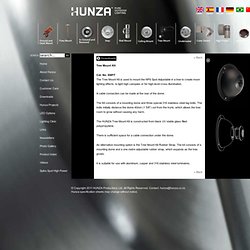
No. SSP/TThe Tree Mount Kit is used to mount the NPS Spot Adjustable in a tree to create moon lighting effects, to light high canopies or for high-level cross illumination. A cable connection can be made at the rear of the dome. The Kit consists of a mounting dome and three special 316 stainless steel lag bolts. The bolts initially distance the dome 40mm (1 5/8”) out from the trunk, which allows the tree room to grow without causing any harm.
The HUNZA Tree Mount Kit is constructed from black UV stable glass filled polypropylene. There is sufficient space for a cable connection under the dome. An alternative mounting option is the Tree Mount Kit Rubber Strap. Hunza Accessories. The Tree Mount Kit has been specifically designed to be mounted to a tree in order to create moonlighting effects (see also Moonlighter Accessory) and to illuminate higher structures in conjunction with a NPS Spot (sold separately).
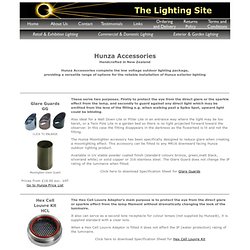
The Tree Mount Kit with Rubber Strap SSP/TRS consists of a mounting dome and a one metre adjustable rubber strap, which expands as the tree grows, causing no harm to the tree. The Tree Mount Kit Screw Fix SSP/T consists of a mounting dome and three 316 stainless steel screws. The screws initially suspend the dome 40mm from the trees surface which allows the tree to grow with out causing any harm. Hunza NPS Spot Tree Mount Rubber Strap. We aim to beat all retail prices available to you and supply Hunza and other top end brands at very competitive prices so please call or email us with your garden lighting enquiry.
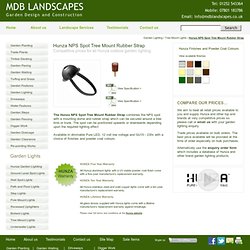
Trade prices available on bulk orders. The best price available will be provided at the time of order especially on bulk purchases. Alternatively use the enquiry order form which includes a database of Hunza and other brand garden lighting products. Tree Mount Combined.cdr - hunza-tree-mount-kit.pdf. NPS Spot.cdr - hunza-nps-spot.pdf. Article : LCN September 2007 Landscape Lighting.
By Michelle Ryan, regional editor Tree lights were used to cover a broad expanse of walkway, turf and driveway.
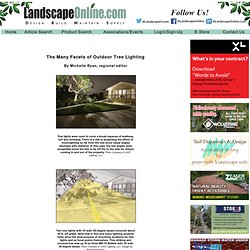
There is a risk in projecting the effect of moonlighting so far from the tree since visual angles decrease with distance. In this case, the low angles were acceptable since the tree is far off the to the side for drivers coming in and out of the property. Photo Courtesy of CAST Lighting, LLC. T5 master_tl5_high_efficiency_eco_310750_ffs_aen.pdf. City Plan Online - Christchurch City Council. LED street lights annoy expert (stuff).pdf. Flare Revalo Notes.pdf. Flare Revalo Notes.pdf. Daylight factor. A daylight factor is the ratio of internal light level to external light level and is defined as follows: DF = (Ei / Eo) x 100% where, Ei = illuminance due to daylight at a point on the indoors working plane, Eo = simultaneous outdoor illuminance on a horizontal plane from an unobstructed hemisphere of overcast sky.
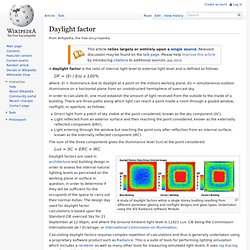
In order to calculate Ei, one must establish the amount of light received from the outside to the inside of a building. There are three paths along which light can reach a point inside a room through a glazed window, rooflight, or aperture, as follows: Direct light from a patch of sky visible at the point considered, known as the sky component (SC),Light reflected from an exterior surface and then reaching the point considered, known as the externally reflected component (ERC),Light entering through the window but reaching the point only after reflection from an internal surface, known as the internally reflected component (IRC). Ask.com Encyclopedia. The Sun is Earth's primary source of light.

About 44% of the sun's electromagnetic radiation that reaches the ground is in the visible light range. Visible light (commonly referred to simply as light) is electromagnetic radiation that is visible to the human eye, and is responsible for the sense of sight.[1] Visible light is usually defined as having a wavelength in the range of 400 nanometres (nm), or 400×10−9 m, to 700 nanometres – between the infrared, with longer wavelengths and the ultraviolet, with shorter wavelengths.[2][3] These numbers do not represent the absolute limits of human vision, but the approximate range within which most people can see reasonably well under most circumstances.
Various sources define visible light as narrowly as 420 to 680[4][5] to as broadly as 380 to 800 nm.[6][7] Under ideal laboratory conditions, people can see infrared up to at least 1050 nm,[8] children and young adults ultraviolet down to about 310 to 313 nm.[9][10][11] Speed of light [edit] F8, 4.5.5, non maintained exits to come on with smoke detection. XLamp XM-L LED Data Sheet - XLampXML.pdf. Flourescent Lighting Controls.pdf. View topic - Aiming Luminaires. View topic - LUMINAIRE AIMING TO A POINT. Simple occupancy and daylight linking lighting control.pdf. Cree shatters LED theoretical maximum efficiency of 200 lumens per watt in the lab. Today Cree announced that they have trounced previous luminous efficiency records of Light Emitting Diodes with 231 lumens per watt being produced by a single-die component.
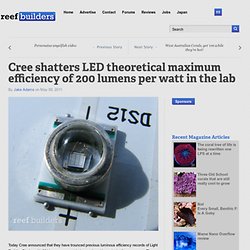
The record-setting efficient LED has a color temperature of 4500K, the results were produced at room temperature and the LED was running at 350mA, or about one watt. Light-emitting diode. Parts of an LED.
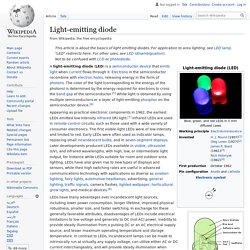
Although unlabeled, the flat bottom surfaces of the anvil and post embedded inside the epoxy act as anchors, to prevent the conductors from being forcefully pulled out via mechanical strain or vibration. An LED is often small in area (less than 1 mm2) and integrated optical components may be used to shape its radiation pattern.[5] Appearing as practical electronic components in 1962,[6] the earliest LEDs emitted low-intensity infrared light.
Infrared LEDs are still frequently used as transmitting elements in remote-control circuits, such as those in remote controls for a wide variety of consumer electronics. The first visible-light LEDs were also of low intensity, and limited to red. Energy Efficiency Lighting. Energy Efficient Lighting.
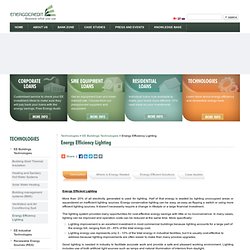
White LED lights with 135 Lumens per Watt About Ten Times Better than Incandescent. Ad Support : Nano TechnologyNetbook Technology News Computer Software Previously white LEDs had a max of about 60 lumens per watt but the new White LEDs have 135 lumens per watt and match the best lighting alternatives The new LED can replace traditional fluorescent bulbs for all general lighting applications, and also be used for automobile headlights and LCD backlighting.
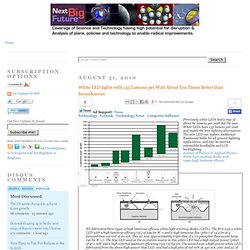
Journal of Physics D: Applied Physics - White light emitting diodes with super-high luminous efficacy We fabricated three types of high luminous efficacy white light emitting diodes (LEDs). J10 HID Lamps and Ballasts - Lighting. This Guide will concentrate on two types of High Pressure Discharge (HID) lamps and ballasts = Metal Halide (MH), High-Pressure Sodium (HPS) – and low-pressure discharge Low Pressure Sodium (LPS) lams and ballasts. For the sake of simplicity, all three technologies will be referred to as HID Lamps and Ballasts.
Another type of HID lamp, the Mercury-Vapor (MV) lamp will only be covered in a cursory manner. MV lamps are becoming obsolete as the other three HID lamps offer increased efficacy, color rendering and lumen maintenance at a lower cost. All HID lamps operate on the same principle. Simply out, when the lamp is turned on, a voltage is applied to initiate an arc at an electrode, which discharges and vaporizes mercury and other metal halides. A. Applications • MV lamps increased in use during the 1940s in industrial and commercial applications due to their longer life and efficacy when compared to standard incandescent lamps. B. Philips_Hadco-Information_Brief_Absolute_And_Relative_Photometry.pdf (application/pdf Object) LabNot03.pdf (application/pdf Object) LightLab - Photometric testing. LightLab offers a comprehensive photometric testing service that is summarised in the table below.
The variety of samples and breadth of testing is substantial, please contact us if your requirements our outside our mainstream testing services. Our technicians have many years of experience and will help you determine what course of action is necessary whatever your testing needs. Our ultimate goal is to supply you with succinct, accurate and meaningful information. Your Photometric Results Information we provide to you takes many forms. For applicable test types (refer to the table below) we will provide photometric data files. IES-LM63-1986 / 91 and 95 CIE format as defined in Pub. 102:1993 Eulumdat TM-14 Phillum version 1.0 and 2.0 Additionally, we can provide the photometric data in a number of popular spreadsheet formats. All of our printed test reports can be supplied in an industry standard electronic format. Through_the_life_costs.pdf (application/pdf Object)
Safe management of pcbs.pdf (application/pdf Object) The Illuminating Engineering Society of Australia and New Zealand Limited. Three Way Switch. LED Lighting efficacy 70 lm/W.